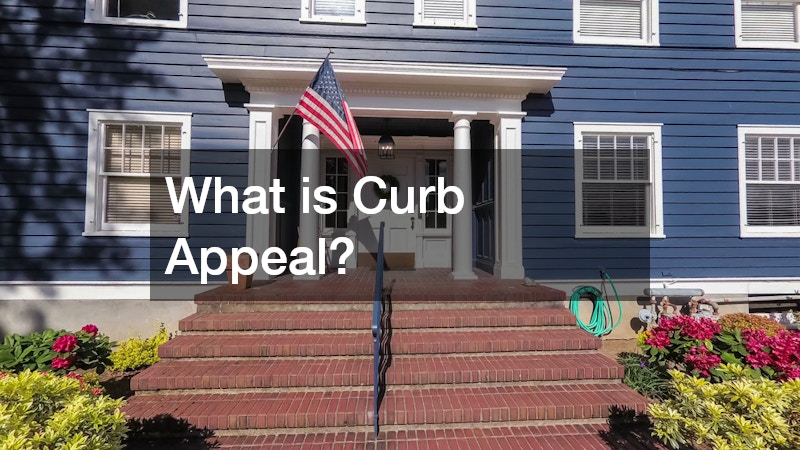

Curb appeal is one of the most influential factors in how a property is perceived by visitors, potential buyers, or clients. A visually appealing exterior creates a lasting impression that communicates pride, attention to detail, and quality. Upgrading a property’s driveway, walkways, and outdoor features through new pavement and thoughtful hardscaping can dramatically transform its appearance. When combined with complementary landscaping, lighting, and functional elements like retaining walls, the result is an inviting, cohesive environment that elevates both aesthetic appeal and property value.
What is Curb Appeal?

Definition and Importance
Curb appeal refers to the attractiveness of a property when viewed from the street. It encompasses more than just visual beauty; it communicates maintenance, organization, and quality. Features such as well-laid pavement, structured hardscaping, and thoughtful landscape design all contribute to curb appeal. For both residential and commercial properties, the exterior sends a message before anyone steps inside, shaping expectations and perceptions.
Impact on Property Value
Investing in curb appeal has tangible financial benefits. Homes with well-maintained driveways, decorative paving, and professionally designed hardscaping often sell faster and at higher prices. For commercial properties, a visually appealing exterior draws more clients and reinforces professional branding. Paving companies and concrete companies that provide durable, well-finished surfaces play a crucial role in maintaining property value and maximizing the return on investment.
Psychological Influence on Buyers
First impressions are often lasting. A property with smooth new pavement, clean walkways, and complementary landscaping immediately signals quality. Buyers subconsciously associate a well-maintained exterior with proper interior care. Hardscaping elements such as retaining walls, terraces, and decorative stonework add visual interest and demonstrate a level of thoughtfulness that enhances buyer confidence.
Differences Between Residential and Commercial
While both residential and commercial properties benefit from curb appeal, priorities differ slightly. Residential spaces emphasize comfort, lifestyle, and aesthetic beauty, often incorporating elements like patios, walkways, and landscape design. Commercial properties focus on functionality, accessibility, and brand alignment, which may involve paving fabric installation to ensure durable surfaces, clear traffic flow, and minimal maintenance. Retaining walls, concrete pathways, and professional landscaping services enhance both types of properties while meeting specific practical needs.
First Impression Factors
The driveway, entryway, and surrounding landscaping are among the first elements noticed from the street. Smooth, freshly paved surfaces with sealcoating, decorative hardscaping, and well-manicured green spaces create a welcoming visual impression. Strategic lighting, carefully placed plantings, and functional retaining walls contribute to an overall sense of order and appeal, inviting exploration of the property’s interior.
Benefits of New Pavement for Curb Appeal
Enhanced Aesthetic Appearance
New pavement immediately upgrades a property’s appearance. Whether asphalt, concrete, or decorative pavers, a well-laid surface creates a polished, modern look. Paving companies specialize in designs that incorporate texture, color, and patterns to complement the surrounding landscape design. When combined with hardscaping elements like retaining walls or stone pathways, new pavement contributes to a cohesive, visually pleasing environment.
Durability and Longevity
Modern paving materials are built for strength and longevity. Asphalt with sealcoating, concrete, and paver stones withstand heavy traffic, weather changes, and daily wear for decades. Properly installed pavement with paving fabric installation ensures stability and reduces the risk of cracking or shifting. This durability not only enhances safety but minimizes future repair costs, maintaining the property’s curb appeal over time.
Low Maintenance Requirements
New pavement typically requires minimal upkeep. Periodic sealcoating preserves asphalt surfaces, while concrete driveways benefit from occasional cleaning and minor repairs. Hardscaping features like retaining walls and stone paths are durable and often require little intervention once installed. Regular lawn care company services for surrounding green spaces further enhance the overall appearance without extensive effort.
Environmental Impact
Sustainable paving choices help reduce environmental impact. Permeable pavements allow rainwater to penetrate the ground, supporting drainage and groundwater replenishment. Paving companies increasingly offer eco-friendly options, while integrating hardscaping elements like retaining walls and terraced landscapes can help manage runoff. Coordinated landscaping service strategies, such as planting native species and maintaining soil integrity, complement sustainable pavement choices.
Financial Advantages
Investing in new pavement provides both short-term and long-term financial benefits. Properties with smooth, well-designed driveways and surrounding hardscaping often sell faster and command higher prices. For commercial properties, enhanced curb appeal attracts more clients and strengthens brand perception. Long-term cost efficiency is achieved through reduced maintenance, durable materials, and strategic design decisions made in consultation with paving companies or a concrete company.
Types of Paving Materials

Asphalt Pavement
Asphalt is widely favored for its affordability, durability, and smooth finish. It is ideal for driveways, parking areas, and heavy-traffic zones. Sealcoating asphalt enhances its longevity and appearance, protecting against UV rays, moisture, and wear. Asphalt can also be layered over properly graded surfaces using land grading service techniques to ensure a level, stable base.
Concrete Pavement
Concrete provides a long-lasting, versatile option for residential and commercial properties. It can be stamped, colored, or textured to complement landscape design or hardscaping elements like retaining walls. Concrete driveways are durable, low-maintenance, and aesthetically flexible. Partnering with a reputable concrete company ensures precise installation and professional finishing.
Paver Stones
Paver stones offer a decorative, high-end aesthetic. Available in a variety of colors, shapes, and textures, they allow for creative driveways, patios, and walkways. Pavers can be integrated with landscaping service plans to create natural transitions between green spaces and hardscaping features. Proper base preparation, often with paving fabric installation, helps maintain stability and durability.
Gravel and Pebbles
Gravel and pebbles provide a natural, rustic look that suits specific landscape designs. They are cost-effective and easy to install, with the added benefit of promoting drainage. Combining gravel with stone walkways, edging, or retaining walls can elevate the visual impact while maintaining functional simplicity.
Comparison of Materials
Each material carries unique benefits. Asphalt is affordable and straightforward but requires periodic sealcoating. Concrete offers long-term durability and design flexibility at higher initial costs. Paver stones provide premium aesthetics and replaceable components but demand precise installation. Gravel is economical and visually appealing but may need frequent topping. Choosing the right material requires evaluating budget, functionality, and compatibility with landscape design and hardscaping elements.
Choosing the Right Hardscaping Design
Assessing Your Property’s Needs
A successful hardscaping plan begins with evaluating your property’s specific requirements. Consider traffic patterns, drainage, and spatial limitations. Elements like retaining walls can address slope issues, while terraces and pathways optimize outdoor usability. Collaborating with a landscaping service or landscape design professional ensures functionality and style are balanced effectively.
Balancing Aesthetics and Functionality
Hardscaping should harmonize with the property’s natural beauty while serving practical purposes. Walkways, patios, and retaining walls should complement lawn care and planting layouts. When paired with durable pavement and proper grading through a land grading service, functional outdoor spaces enhance accessibility and safety while preserving aesthetic appeal.
Complementing Existing Landscaping
Hardscaping should seamlessly integrate with existing landscaping. Borders, edges, and terraced retaining walls can highlight lawns, gardens, and trees. Collaboration with a landscaping service ensures that hardscaping elements and green spaces work in harmony, creating a visually cohesive outdoor environment.
Design Trends in Hardscaping
Modern hardscaping trends emphasize clean lines, multifunctional outdoor areas, and sustainable choices. Features like fire pits, water elements, decorative stone walls, and integrated lighting enhance both visual appeal and usability. Paving fabric installation beneath patios or walkways adds durability while allowing for creative design layouts that complement landscape design.
Professional Design vs DIY
While DIY hardscaping projects can be satisfying, professional design ensures structural integrity, safety, and long-term durability. Paving companies, concrete companies, and landscape design professionals provide expertise in site preparation, material selection, and installation. This professional approach reduces risk of uneven surfaces, improper drainage, or aesthetic inconsistencies.
Installation Process for New Pavement
Preparing the Site
Proper site preparation is essential for pavement longevity. Clearing debris, removing old surfaces, and assessing drainage prevent future problems. A land grading service can establish a stable base, ensuring proper water runoff and preventing erosion. These steps set the foundation for a durable, visually appealing pavement installation.
Creating a Solid Base
A strong foundation supports the pavement for decades. Crushed stone or gravel is compacted to provide stability. Paving fabric installation reinforces the base, preventing shifting and extending the lifespan of asphalt, concrete, or paver surfaces. This preparation also complements adjacent hardscaping elements such as retaining walls and garden terraces.
Laying the Material
Once the base is prepared, paving companies install the selected material. Asphalt is poured and smoothed, concrete is poured and finished, and pavers are arranged in creative patterns. Attention to detail ensures even surfaces, proper alignment, and a professional finish that enhances curb appeal.
Sealing and Finishing Touches
Sealcoating asphalt or applying protective finishes to concrete preserves appearance and durability. Hardscaping elements like retaining walls, decorative stones, and borders add final visual impact. Integrating landscaping service plans, lighting, and green spaces creates a cohesive, welcoming exterior.
Common Installation Challenges
Common challenges include uneven subsoil, drainage issues, and weather delays. Experienced paving companies, concrete companies, and landscape design professionals can anticipate and address these challenges. Proper planning ensures the project is completed efficiently and that the final pavement and hardscaping remain functional and visually striking.
Maintenance Tips for New Pavement

Regular Cleaning and Upkeep
Routine cleaning is crucial to preserve curb appeal. Sweeping, washing, and removing debris keep surfaces pristine. Hardscaping features like retaining walls, stone paths, and borders require occasional attention to prevent plant overgrowth or soil erosion.
Sealing and Repairs
Periodic sealcoating of asphalt and concrete surfaces protects against weathering, stains, and wear. Prompt repair of cracks or minor damage maintains structural integrity and prevents costly long-term issues.
Seasonal Care Routines
Different seasons bring unique maintenance needs. Winter snow removal, spring cleaning, and summer care routines for pavement and hardscaping extend lifespan. Lawn care company services can coordinate seasonal care with hardscaping maintenance for a comprehensive approach.
Preventing Weed and Moss Growth
Weeds and moss can compromise both aesthetics and stability. Paving fabric installation and professional landscaping service interventions prevent growth along joints, edges, and retaining wall bases. This ensures a clean, safe, and visually appealing surface year-round.
Dealing with Stains and Spills
Promptly addressing spills from oil, food, or chemicals prevents staining and surface damage. Sealcoating and protective treatments further safeguard pavement surfaces, preserving their long-lasting appeal.
Cost Considerations for New Pavement
Material Costs
Material costs vary depending on type, quality, and design. Asphalt and concrete are common choices, while paver stones and decorative options carry higher initial expenses. Investing in durable materials and professional installation enhances long-term value.
Labor Costs
Labor costs account for expertise, equipment, and project complexity. Paving companies and concrete companies provide professional installation that ensures proper grading, structural stability, and aesthetically appealing finishes.
Long-term Cost Efficiency
High-quality pavement paired with hardscaping, retaining walls, and proper land grading service techniques reduces long-term maintenance expenses. Sealcoating, paving fabric installation, and landscape design coordination contribute to long-lasting, cost-effective results.
Budgeting for Maintenance
Regular maintenance is essential to preserve curb appeal and functionality. Incorporating lawn care company services, landscaping service routines, and sealcoating schedules into the budget ensures the property remains attractive and well-maintained.
Cost vs. Value Added
Investing in quality materials, professional paving companies, hardscaping, and landscaping services delivers significant returns. Enhanced curb appeal increases property value, attracts buyers or clients, and creates a welcoming environment that justifies the investment.
How to Select a Contractor
Evaluating Expertise and Experience
Selecting the right contractor is critical for successful pavement and hardscaping projects. Look for paving companies or concrete companies with proven experience, portfolios of previous work, and specialized knowledge in both installation and design.
Checking Licenses and Certifications
Verified licenses and certifications ensure that contractors adhere to local regulations and industry standards. This protects the property owner and guarantees professional quality for both pavement and hardscaping projects.
Reviewing Proposals and Estimates
Carefully comparing proposals, estimates, and material options allows homeowners to make informed decisions. Professional contractors provide transparent breakdowns, helping clients understand costs, timelines, and project scope.
Understanding Contract Terms
Clear contract terms protect both parties and outline responsibilities, timelines, and expectations. Including provisions for maintenance, warranty, and post-installation care ensures that pavement, hardscaping, and landscaping services meet long-term needs.
Importance of Reviews and References
Feedback from previous clients offers insight into contractor reliability, quality, and professionalism. Positive reviews and strong references from both residential and commercial projects indicate trustworthy, skilled professionals for pavement and hardscaping work.
Eco-Friendly and Sustainable Pavement Options
Permeable Paving Systems
Permeable pavements allow water to seep through, reducing runoff and protecting local water systems. These systems work well with hardscaping designs and retaining walls, integrating functionality with environmental responsibility.
Recycled Material Usage
Using recycled asphalt, concrete, or pavers reduces waste and minimizes environmental impact. Many paving companies offer eco-friendly options, combining durability with sustainable design choices.
Water Management and Conservation
Proper land grading service, drainage planning, and permeable pavements improve water management. Landscaping service plans that incorporate native plants and strategic irrigation complement eco-friendly hardscaping and pavement choices.
Green Certifications
Properties using sustainable materials and responsible installation practices can achieve green certifications. These designations demonstrate environmental responsibility, enhance curb appeal, and may improve property value.
Benefits of Sustainable Choices
Sustainable pavement and hardscaping choices reduce maintenance costs, minimize environmental impact, and contribute to a healthier, more visually appealing property. Integrating eco-conscious practices into landscape design and installation ensures long-term aesthetic and functional benefits.
Enhancing Curb Appeal with Complementary Landscaping
Integrating Green Spaces
Lush lawns, flower beds, and well-placed trees enhance the visual appeal of new pavement and hardscaping. A lawn care company can provide ongoing maintenance to ensure vibrant, healthy green spaces that complement walkways, patios, and driveways. Incorporating thoughtful front yard landscaping ties all elements together, creating a cohesive and inviting exterior that impresses visitors and potential buyers.
Incorporating Lighting and Features
Outdoor lighting highlights hardscaping features, guides pathways, and creates ambiance. Features like benches, water elements, and stone retaining walls further enhance the property’s visual impact.
Creating Walkways and Paths
Functional walkways connect different outdoor areas and define space. Paving companies and landscape design professionals collaborate to create paths that are durable, attractive, and in harmony with surrounding greenery.
Using Borders and Edges
Borders and edging define spaces, prevent erosion, and contribute to a polished look. Stone walls, timber edging, or low retaining walls complement hardscaping and landscaping service plans, creating a cohesive outdoor environment.
Seasonal Plant Choices
Incorporating seasonal flowers and plants keeps the property visually appealing year-round. A well-executed landscape design, combined with pavement and hardscaping, ensures continuous curb appeal regardless of season.
Closing Thoughts
Enhancing curb appeal through new pavement and hardscaping transforms both residential and commercial properties. Carefully selected materials, professional installation, and complementary landscaping create lasting visual appeal, functional outdoor spaces, and long-term property value. By incorporating strategies like sealcoating, paving fabric installation, retaining walls, and eco-conscious design choices, property owners can achieve a polished, durable, and inviting exterior that leaves a remarkable first impression.


